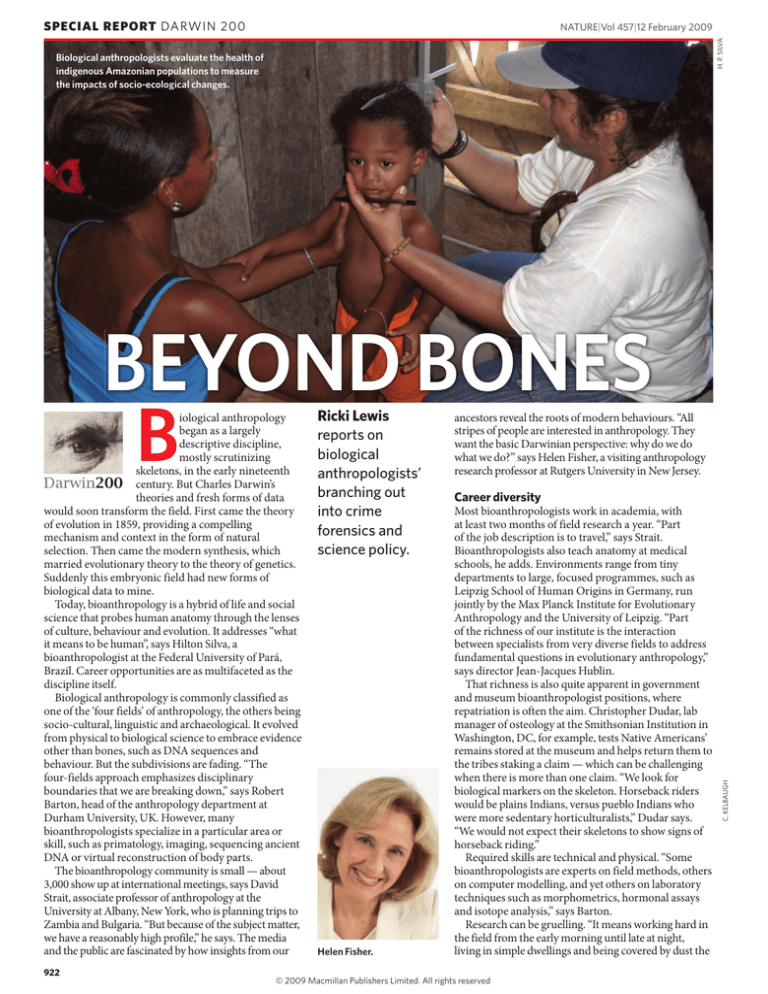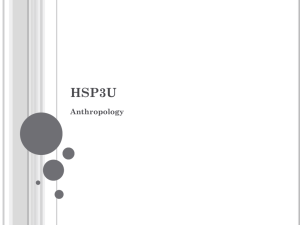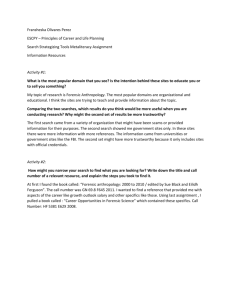
SPECIAL REPORT DARWIN 200
H. P. SILVA
NATURE|Vol 457|12 February 2009
Biological anthropologists evaluate the health of
indigenous Amazonian populations to measure
the impacts of socio-ecological changes.
BEYOND BONES
922
Ricki Lewis
reports on
biological
anthropologists’
branching out
into crime
forensics and
science policy.
Helen Fisher.
ancestors reveal the roots of modern behaviours. “All
stripes of people are interested in anthropology. They
want the basic Darwinian perspective: why do we do
what we do?” says Helen Fisher, a visiting anthropology
research professor at Rutgers University in New Jersey.
Career diversity
Most bioanthropologists work in academia, with
at least two months of field research a year. “Part
of the job description is to travel,” says Strait.
Bioanthropologists also teach anatomy at medical
schools, he adds. Environments range from tiny
departments to large, focused programmes, such as
Leipzig School of Human Origins in Germany, run
jointly by the Max Planck Institute for Evolutionary
Anthropology and the University of Leipzig. “Part
of the richness of our institute is the interaction
between specialists from very diverse fields to address
fundamental questions in evolutionary anthropology,”
says director Jean-Jacques Hublin.
That richness is also quite apparent in government
and museum bioanthropologist positions, where
repatriation is often the aim. Christopher Dudar, lab
manager of osteology at the Smithsonian Institution in
Washington, DC, for example, tests Native Americans’
remains stored at the museum and helps return them to
the tribes staking a claim — which can be challenging
when there is more than one claim. “We look for
biological markers on the skeleton. Horseback riders
would be plains Indians, versus pueblo Indians who
were more sedentary horticulturalists,” Dudar says.
“We would not expect their skeletons to show signs of
horseback riding.”
Required skills are technical and physical. “Some
bioanthropologists are experts on field methods, others
on computer modelling, and yet others on laboratory
techniques such as morphometrics, hormonal assays
and isotope analysis,” says Barton.
Research can be gruelling. “It means working hard in
the field from the early morning until late at night,
living in simple dwellings and being covered by dust the
© 2009 Macmillan Publishers Limited. All rights reserved
C. KELBAUGH
B
iological anthropology
began as a largely
descriptive discipline,
mostly scrutinizing
skeletons, in the early nineteenth
century. But Charles Darwin’s
theories and fresh forms of data
would soon transform the field. First came the theory
of evolution in 1859, providing a compelling
mechanism and context in the form of natural
selection. Then came the modern synthesis, which
married evolutionary theory to the theory of genetics.
Suddenly this embryonic field had new forms of
biological data to mine.
Today, bioanthropology is a hybrid of life and social
science that probes human anatomy through the lenses
of culture, behaviour and evolution. It addresses “what
it means to be human”, says Hilton Silva, a
bioanthropologist at the Federal University of Pará,
Brazil. Career opportunities are as multifaceted as the
discipline itself.
Biological anthropology is commonly classified as
one of the ‘four fields’ of anthropology, the others being
socio-cultural, linguistic and archaeological. It evolved
from physical to biological science to embrace evidence
other than bones, such as DNA sequences and
behaviour. But the subdivisions are fading. “The
four-fields approach emphasizes disciplinary
boundaries that we are breaking down,” says Robert
Barton, head of the anthropology department at
Durham University, UK. However, many
bioanthropologists specialize in a particular area or
skill, such as primatology, imaging, sequencing ancient
DNA or virtual reconstruction of body parts.
The bioanthropology community is small — about
3,000 show up at international meetings, says David
Strait, associate professor of anthropology at the
University at Albany, New York, who is planning trips to
Zambia and Bulgaria. “But because of the subject matter,
we have a reasonably high profile,” he says. The media
and the public are fascinated by how insights from our
DARWIN 200 SPECIAL REPORT
G. BALLY/KEYSTONE
whole day,” says Albert Zink, head of the Institute for
Mummies and the Iceman in Bolzano, Italy. For those
more comfortable in front of a computer screen, virtual
anthropology is an approach that models human
skeletal variability. The European Virtual Anthropology
Network (EVAN), based at the University of Vienna,
funds young scientists to apply this technology. For
example, an EVAN-supported company has developed
a three-dimensional face-recognition system for use in
security, based on anthropological research.
Other skills are less high-tech. Some
bioanthropologists must, for example, feel comfortable
with sifting through dog faeces for human bone
fragments or identifying the species and developmental
stage of larvae feasting on a corpse to get clues about a
person’s death. An intimate familiarity with the human
skeleton and its response to stress is crucial, says
Cassandra Kuba, chief forensic anthropologist in the
Department of Justice, Law and Society at California
University of Pennsylvania. And fieldwork may require
learning a language, says Pancras Ngalason, executive
director of the Jane Goodall Institute in Dar es Salaam,
Tanzania, where understanding Swahili is necessary.
Frank Ruehl (above) analyses a mummified foot.
MAX PLANCK INST. FOR EVOLUTIONARY ANTHROPOLOGY LEIPZIG
Bigger picture
The most important skill for a bioanthropologist is,
perhaps, a “deep curiosity to understand our species,
our evolution and our relationship to the natural world”,
says Jay Stock, director of studies in archaeology and
anthropology at the University of Cambridge, UK. All
areas of bioanthropology also share what anthropologist
Eugenie Scott, executive director of the National Center
for Science Education based in Berkeley, California, calls
“a holistic, systems view” of standing back and letting
the stories emerge from the clues.
This holistic perspective and the necessary skill set
mean bioanthropology thrives on collaborations —
such as with radiologists, palaeontologists and dentists.
And that presents challenges. “Directing such research
teams requires a wide range of skills beyond the
scientific: managerial and project management,
diplomatic, financial and people skills,” says Darren
Curnoe, co-director of the palaeosciences laboratory at
the University of New South Wales in Sydney,
Australia. His research on the spread of modern
humans to east Asia during the late Pleistocene epoch
requires him to have knowledge in geology,
geochronology, genetics and archaeology.
These days, bioanthropologists often forge careers
involving more modern detective work. Forensic
anthropologists may work in academia while helping
local law enforcement a few times a year. Others work
for medical examiner’s offices, for the government or in
organizations such as Médecins Sans Frontières.
Kuba landed her dream job in forensic anthropology
shortly after earning her PhD. She teaches
undergraduates, local law enforcement, coroners and
attorneys in the university’s Institute of Criminological
and Forensic Sciences, but she enjoys casework the most.
Suppose a hiker comes across a decomposed skeleton in
the woods. The forensic anthropologist, she explains,
recovers the remains and transfers them to the lab for
processing and analysis, then determines the
postmortem interval, analyses trauma and burns, and
probes skeletal traits that may help identification.
Christopher King, forensic anthropologist for the
US Army’s Mass Graves Investigation Team in Iraq, has
David Strait (top) and
Eugenie Scott (above).
uncovered victims of war, plane crashes, terrorist attacks
and tsunamis. Back in the 1980s, the job required only
identifying and returning the remains of relatives to
families. New technology allows anthropologists to
analyse the trauma that the deceased experienced in far
more detail. “As a result, there is an increased need for
trained professionals to excavate and analyse human
remains using strict scientific methods that will stand up
to courtroom scrutiny,” says King. “With terrorist groups
and large-scale natural disasters seemingly on the rise,
this type of investigation will continue to grow.”
Some have to a study remains from a different
perspective. Tal Simmons, principal lecturer in forensic
anthropology and archaeology at the University of
Central Lancashire in Preston, UK, specializes in
taphonomy, the study of decaying organisms. She
watches pigs rot, extrapolating the findings to humans.
“We help the police determine how long ago a person
died,” she says. Her work entails determining the
subject’s age, ‘race’, sex and build, the features of
pathology or trauma, and consulting records of daily
temperatures to calculate the stage of decomposition.
Bioanthropology, though, has reached beyond the
bare-bones analysis of the lab and the dig site,
providing careers linked to serious social issues.
Trained as a physical anthropologist, Scott has forged a
career as a leading figure in the movement to keep
intelligent design and creationism out of science
classrooms. “I had to learn about religion, education,
the law, politics and how to run a not-for-profit,” she
says. “It was never boring.”
Bioanthropologists have even moved into the realm of
popular culture. In 1975, Fisher approached her
anthropologist PhD mentor — “How do you do
anything with anthropology in the real world?” she
asked in frustration. He had no answer. Nevertheless, she
found a way to successfully combine serious research on
pair-bonding with projects that bring anthropology to
the masses. Fisher often appears on talk shows; she also
created the dating website chemistry.com and she
consults for the dating website match.com, where she
tries to elucidate the physiological bases for attractions
among different personalities.
Whether investigating mummified remains or
inquiring into the bonds of love, bioanthropologists
apply their expertise to probe many aspects of the
human condition. “Evolution is another way to
contemplate the beauty of life and the origin of human
complexity,” says Hublin.
■
Ricki Lewis is a science writer in Scotia, New York.
Jean-Jacques Hublin.
For more on Darwin, see www.nature.com/darwin.
© 2009 Macmillan Publishers Limited. All rights reserved
923
M. SCHMIDT
S. MIRSKI
NATURE|Vol 457|12 February 2009







